Everyone Forgets Midoriya Is a Beef Cake
This post may contain affiliate links. Please read my disclosure policy for details. As an Amazon Associate, I earn from qualifying purchases.
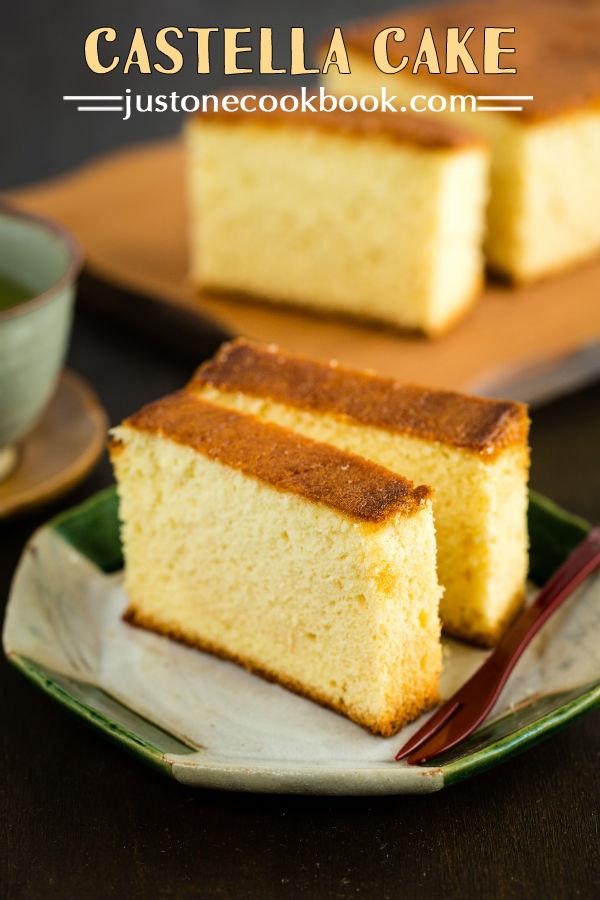
Treat yourself with this super moist Japanese sponge cake with a hint of sweetness from honey! Made with only 4 ingredients, Japanese Castella Cake is a very popular confectionery in Japan. Try this delicious cake for your weekend baking project. It makes the perfect holiday or hostess gift too.
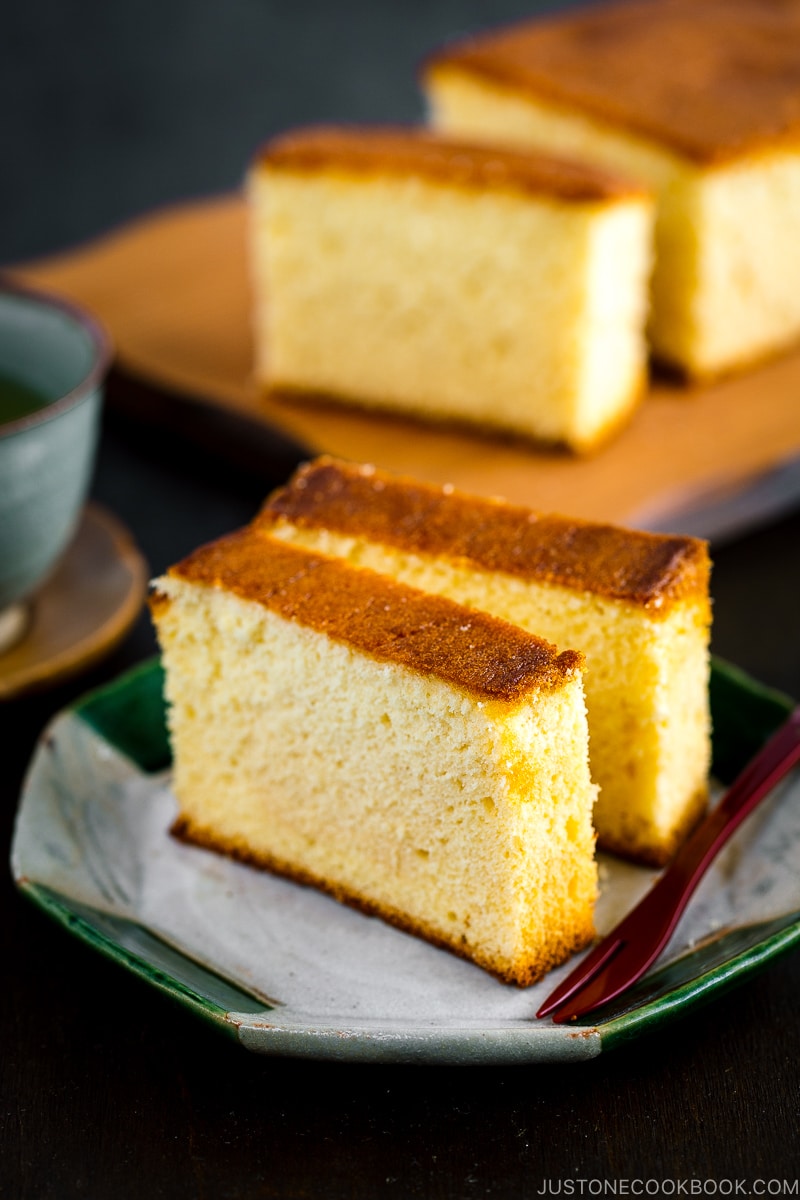
Japanese Castella Cake, or Kasutera (カステラ) in Japanese, is a popular Japanese honey sponge cake which was originally introduced by the Portuguese merchants to Nagasaki area in the 16th century. The name is derived from Portuguese Pão de Castela, meaning "bread from Castile". Castella is made of just 4 basic ingredients: bread flour, eggs, sugar, and honey.
A dark brown top and bottom crusts with a creamy yellow center give a beautiful contrast to the sponge cake. This delicate cake is very moist, smooth, bouncy, and has just enough sweetness with a fragrance of honey.
Watch How to Make Castella
Castella (カステラ) is a delicious Japanese sponge cake made with bread flour, sugar, honey, and eggs. My family loves Castella and it goes very well with both tea and coffee.
The difference between Japanese honey sponge cake and the regular western sponge cake is Japanese Castella is more delicate and bouncy in texture. It is raised solely by egg foam. There is no butter, oil or any leavening agent like salt or baking powder. It also uses bread flour (higher gluten content) instead of regular flour to achieve the result. The flavor is very light with mild sweetness. Therefore the cake is delightful to enjoy green tea or iced coffee during summertime.
You can tell by its popularity as Castella is being sold everywhere in Japan, from departmental stores, specialty sweet stores to convenience stores. They often come in a slim rectangle box in simple plastic packaging for an everyday snack or fanciful packaging for gifting.
Traditionally, Japanese Castella cake is baked slowly in a wooden frame to create a soft smooth texture for the sponge because a metal baking pan would transfer the heat too fast and it would become too dry. I assume most of you would not have a wooden frame readily available, so my Castella recipe uses a standard 1-lb loaf pan.
I searched for Castella recipes in Japanese and found hundreds of recipes available online. The majority of them use just the same 4 ingredients with slightly different measurements for each recipe. I started to experiment with measurement for each ingredient for my 1-lb loaf pan. Then I increased to two pans as my family really loves this light and moist Japanese Castella Cake for oyatsu (snack).
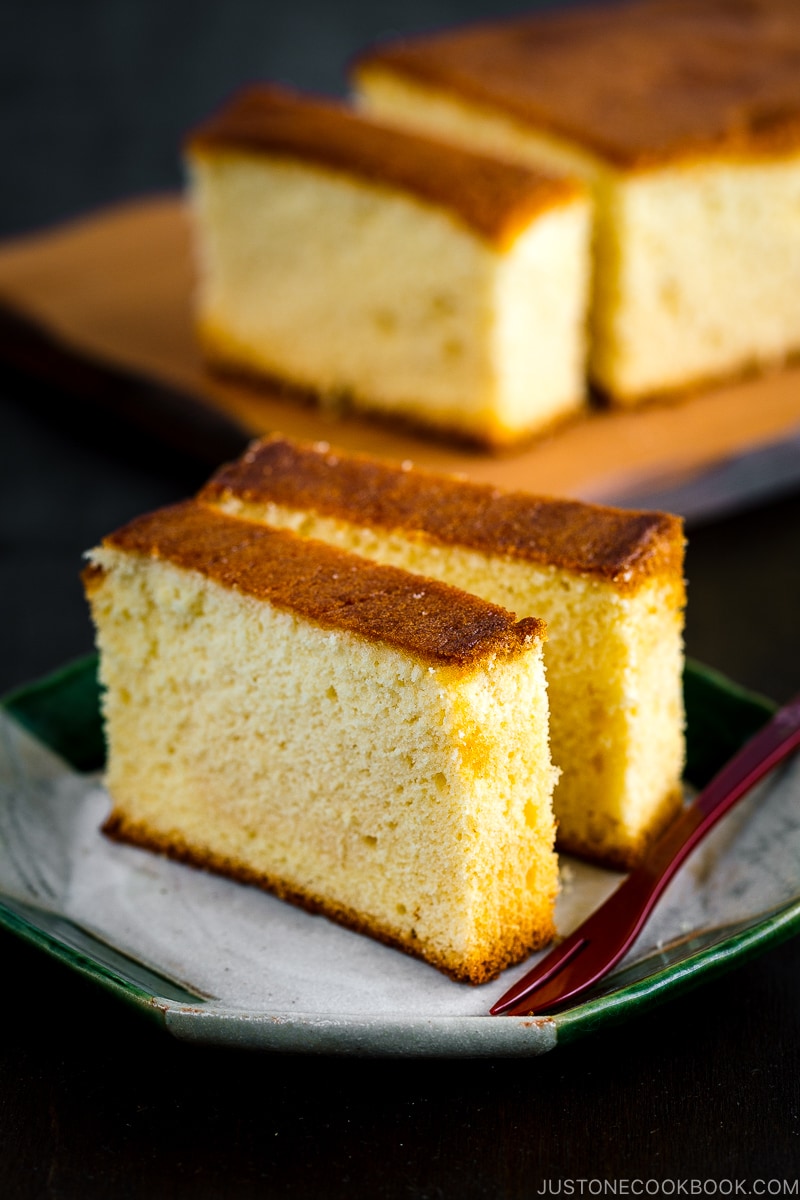
Before I move on to the recipe, I want to mention that it took me a very long time to finalize this recipe. Since then I have been using this exact recipe many times and it worked each time. However, please understand that everyone's oven works differently and you may need to adjust the recipe according to your oven.
Japanese Castella Cake Baking Notes:
The key to a successful Castella is in the beating of the eggs and baking time. Even after trying many times, I still wish to improve the slight wrinkled top (Any tips, anyone?). Otherwise, the texture and flavor is just perfect!
Before I realized that I needed to create my own recipe that works for my oven, I had tried many other Castella recipes I found online. However, I failed miserably despite the beautiful pictures shared on those recipes. Here are some of the tips I learned from my experience in achieving the perfect texture:
Failure 1: A hard and dense layer formed at the bottom of the cake although the top layer turned out beautifully.
Tips:
- There needs to be enough air beaten into the batter for the cake to rise. Make sure to beat the eggs based on the time specified. The texture will be thick and the color will be pale yellow. When you stop the mixer and lift the whisk attachment, the mixture should fall in ribbons.
- Sift the flour two times to loosen.
Failure 2: The cake sank in the middle during the baking, or after I pulled out from the oven.
Tips:
- Bake it longer until the cake is firm and fully cooked inside.
- Do not over mix the batter when you add the flour mixture.
- Must use bread flour.
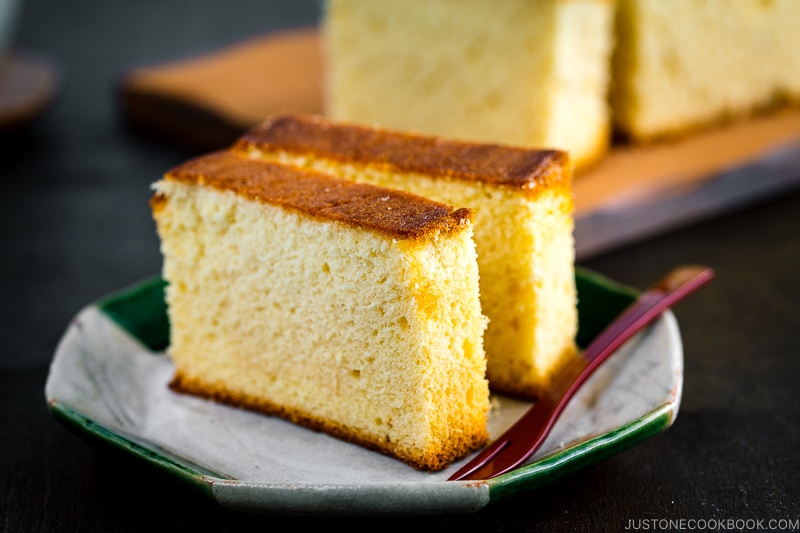
A lot of recipes suggested to bake at a higher temperature and cover the cake with the aluminum foil to prevent the cake from browning further and finish baking. However, this made the cake start to sink immediately and it didn't work for me… Therefore, I couldn't bake at a higher temperature than 320 ºF (160 ºC).
Some recipes suggest baking it at a higher temperature to brown the top first, then change to lower temperature to continue baking. But being unable to cover the top with aluminum foil, my only option was to bake at 320 ºF (160 ºC) and slowly brown the top without overcooking inside of the cake.
You may need to tweak my recipe in order to get the perfect result. I have also seen some recipes that require extra steps and ingredients, but I made this recipe as simple as possible without losing authentic flavor. I hope my recipe works for you and you will get to enjoy Castella with your family and friends.
I've also included a 3-minute Japanese Castella Cake recipe video above, so I hope you will check it out.
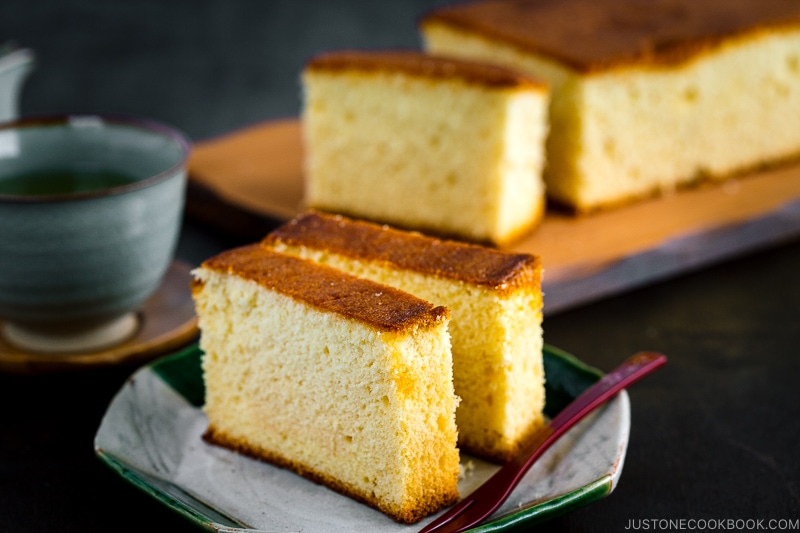
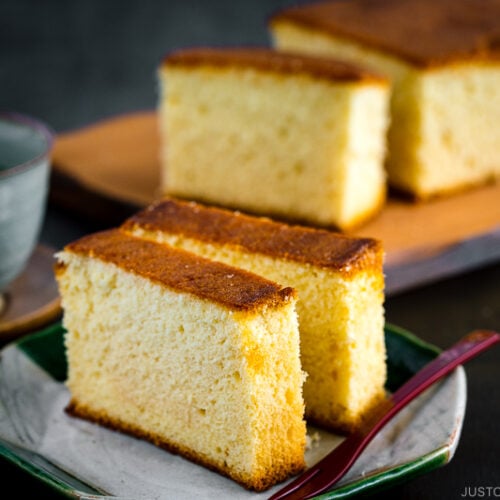
Castella Cake
Treat yourself to this super-moist Japanese sponge cake with a hint of honey! Made with only 4 ingredients, Castella Cake is a very popular confection in Japan. Try this delicately sweet cake for your weekend baking project. It makes the perfect holiday or hostess gift, too.
Servings: 2 Castella Cakes
Prevent your screen from going dark
- 6 large eggs (50 g each w/o shell) (at room temperature--very important!)
- 1 cup sugar
- 1⅔ cup bread flour (Castella has an elastic, bouncy texture from bread flour; you cannot achieve this texture using all-purpose flour)
- ⅓ cup honey (5 Tbsp + 1 tsp to be precise for 2 cakes)
- 2½ Tbsp water (warm)
For the Honey Syrup
- 1 Tbsp honey
- ½ Tbsp water (warm)
Japanese Ingredient Substitution: If you want substitutes for Japanese condiments and ingredients, click here.
-
Gather all the ingredients. Preheat the oven to 320ºF (160ºC). For a convection oven, reduce the oven temperature by 25ºF (15ºC) to 295ºF (145ºC).
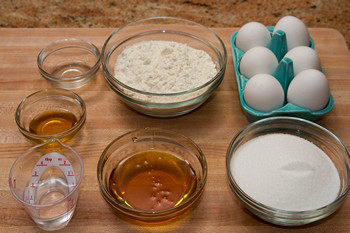
-
Cut the parchment paper to fit the baking pans (see the video for this process). You will need two loaf pans (8½ x 4½ x 2¾ inches, or 22 x 11 x 7 cm). If your pans are smaller, add the excess batter to another smaller pan and use a shorter bake time.
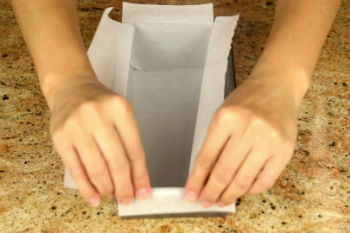
To Make the Batter
-
Sift the bread flour twice with either a sifter or fine-meshed strainer. Holding the handle of the strainer with one hand and tapping it gently with the other, the flour will gradually sift through the strainer.
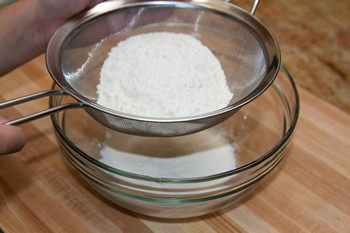
-
Add the warm water to the honey and whisk well.

-
Fit a stand mixer with the whisk attachment. Crack the eggs into the bowl of the mixer and vigorously whisk until combined.
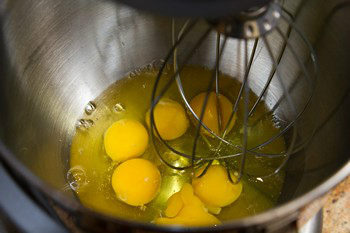
-
Add the sugar.
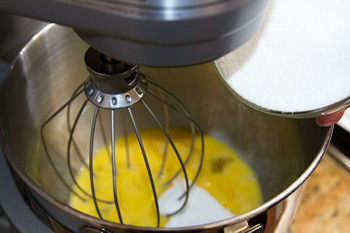
-
Beat the eggs and sugar on high speed (Speed 10) for 5 minutes. If you beat the eggs with a handheld mixer, it will take more time. The beaten eggs will quadruple in volume. The texture will be thick and the color will be pale yellow. When you stop the mixer and lift the whisk attachment, the mixture should fall in ribbons.

-
Add the honey mixture into the egg mixture and whisk on low speed (Speed 2) until combined, about 30 seconds.
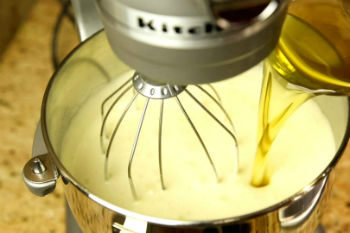
-
Add the bread flour in three parts. Add one-third of the bread flour and whisk at low speed (Speed 2) for 15 seconds. Then, add another third and whisk for another 15 seconds. Finally, add the last remaining portion and whisk until just combined for about 1 minute. Do not overmix.

To Bake
-
Spray the loaf pans with oil and distribute it evenly with a pastry brush.

-
Put the parchment paper in the pans and make sure the paper sticks to the pans. If is does not, apply more oil to the pan, spread it evenly with a brush, and place the parchment paper again.
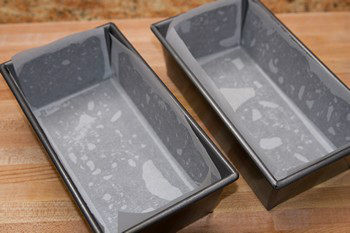
-
Pour the batter into the pans about 80% full.
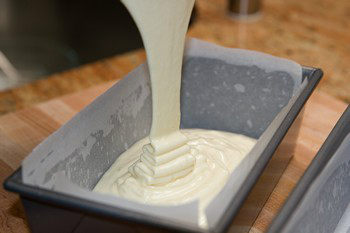
-
Using a skewer, draw a zigzag line through the batter to remove the air bubbles in the batter.
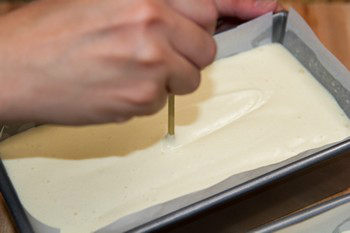
-
Level the batter by holding each pan 2 inches above the counter and dropping it flat onto the counter. Do this several times to release the air bubbles.
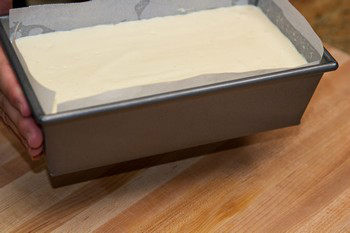
-
Bake at 320ºF (160ºC) in the middle rack of the oven for 35 to 40 minutes, or until golden brown and a skewer inserted in the center comes out clean. I bake my cakes for 35 minutes, at which point I open and leave my oven door ajar for a few minutes. Then, I take out the cakes. When done, the cake sides will pull away from the pan slightly; the top will be flat and feel spongy when pressed with a finger.
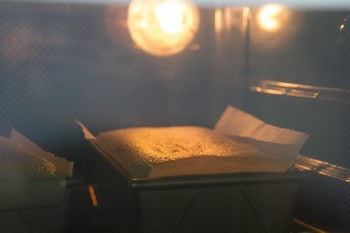
To Apply the Syrup and Chill Overnight
-
To make the honey syrup, mix the honey and warm water in a bowl. Apply the honey syrup over the top of the cakes with a pastry brush.

-
For each cake, place a sheet of plastic wrap on the countertop. Take out the hot cakes from the pan and place them top down on the plastic wrap. Gently peel off the parchment paper.

-
Immediately wrap the cakes with the plastic wrap to retain moisture. While they're still warm, put the wrapped cakes in the refrigerator and store overnight (or at least 12 hours), keeping the top side facing down. This will help the cakes develop a fine and moist texture.
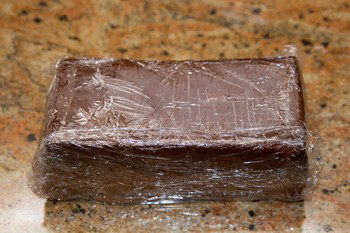
To Serve
-
Remove the cake from the refrigerator. It's better if you bring the cake to room temperature. Slice off the four sides of the cake with a sharp bread knife and cut the cake into ¾- to 1-inch-thick slices (you will get 7-8 slices total). Serve it with tea or coffee, if you'd like.
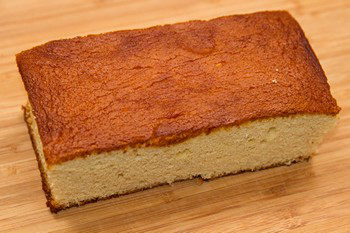
To Store
-
To save for later, wrap individual pieces with plastic wrap. You can store at room temperature for up to 3-4 days, 5-7 days in the refrigerator, and 1 month in the freezer.
Serving: 1 loaf · Calories: 1116 kcal · Carbohydrates: 215 g · Protein: 31 g · Fat: 16 g · Saturated Fat: 5 g · Polyunsaturated Fat: 4 g · Monounsaturated Fat: 6 g · Trans Fat: 1 g · Cholesterol: 558 mg · Sodium: 218 mg · Potassium: 335 mg · Fiber: 3 g · Sugar: 142 g · Vitamin A: 812 IU · Vitamin C: 1 mg · Calcium: 106 mg · Iron: 4 mg
Course: Dessert
Cuisine: Japanese
Keyword: moist cake, sponge cake
©JustOneCookbook.com Content and photographs are copyright protected. Sharing of this recipe is both encouraged and appreciated. Copying and/or pasting full recipes to any website or social media is strictly prohibited. Please view my photo use policy here.
If you made this recipe, snap a pic and hashtag it #justonecookbook! We love to see your creations on Instagram @justonecookbook!
Subscribe Now!
5 Secrets to Japanese Cooking: Simple Meals & Authentic Flavors!
Sign up to receive our FREE email series on Japanese cooking tips and weekly newsletter.
Source: https://www.justonecookbook.com/castella/

0 Response to "Everyone Forgets Midoriya Is a Beef Cake"
Post a Comment